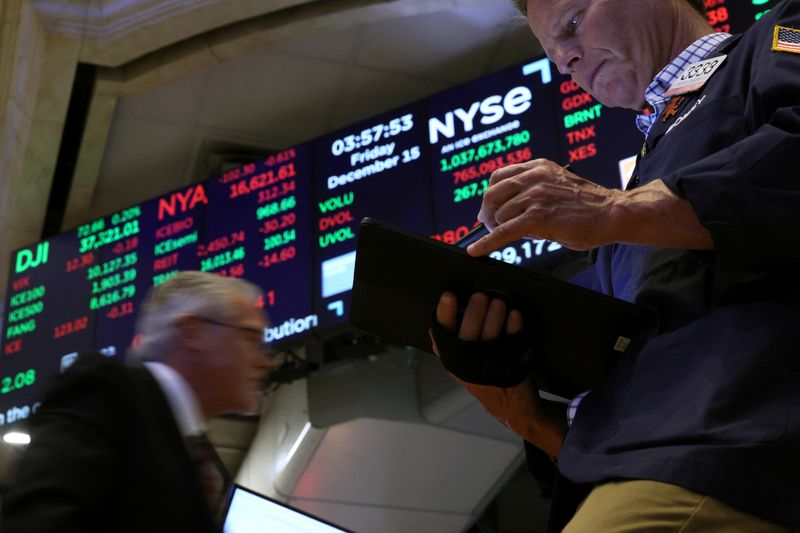By Stephen Culp
NEW YORK (Reuters) -U.S. stocks gained ground on Monday as market participants parsed mounting expectations of interest rate cuts from the Federal Reserve in the coming year and looked ahead to a week of crucial economic data.
A broad but modest rally boosted the S&P 500 and the Nasdaq to solid gains, while the Dow ended flat.
"Markets are heading in the direction of the Fed beginning to cut interest rates next year," said Tom Hainlin, national investment strategist at U.S. Bank Wealth Management in Minneapolis. "The data, whether it’s inflation, consumer spending or the labor market, are not ... deteriorating too fast or running too hot, so that Goldilocks scenario continues to play out."
Wall Street continues to build on seven straight weeks of gains, the S&P 500's longest weekly winning streak since 2017.
The S&P 500 is now about 1.2% shy of its all-time closing high, amid growing optimism regarding policy rate cuts in 2024, a fervor that Fed policy makers attempted to rein in on Monday.
Chicago Fed President Austan Goolsbee warned that the central bank has not pre-committed to cutting rates anytime soon, while Cleveland Fed President Loretta Mester said financial markets had got "a little bit ahead" of the central bank with respect to the timing and extent of interest rate cuts.
Even so, financial markets have priced in a 63.4% likelihood that the central bank will lower its Fed funds target rate by 25 basis points at its March monetary policy meeting, according to CME's FedWatch tool.
"There’s still a disconnect between investors pricing in five to six cuts next year and the Fed dots that show three," Hainlin added. "Markets continue to run ahead of the Fed and it seems to imply that it’s less important how many cuts, just that there’s going to be cuts."
Later in the week, the Commerce Department is expected to release its third and final take on third-quarter GDP on Thursday, to be followed by its broad-ranging Personal Consumption Expenditures (PCE) report on Friday, which will cover income growth, consumer spending, and crucially, inflation.
The Dow Jones Industrial Average held steady at 37,306.02, the S&P 500 gained 21.37 points, or 0.45%, to 4,740.56 and the Nasdaq Composite added 90.89 points, or 0.61%, to 14,904.81.
Of the 11 major sectors in the S&P 500, communication services advanced the most, with real estate and utilities ending the session red.
Mounting attacks by militant groups on ships in the Red Sea sent crude prices higher over supply concerns, which in turn boosted energy stocks, which have largely been left behind by the recent rally.
S&P 500 energy stocks added 0.8%.
United States Steel (NYSE:X) jumped 26.1% to a more than 12-year high after Japan's Nippon Steel announced it would buy the steelmaker in a $14.9 billion deal including debt.
Apple (NASDAQ:AAPL) dipped 0.9% as China's ban on the company's iPhones and other foreign-made gadgets gathered momentum.
VF Corp (NYSE:VFC) slid 7.8% following its announcement that it was investigating "unauthorized" activity on its computer systems, which disrupted some of its business, including the ability to fulfill orders on its e-commerce site.
Advancing issues outnumbered declining ones on the NYSE by a 1.12-to-1 ratio; on Nasdaq, a 1.15-to-1 ratio favored decliners.

The S&P 500 posted 31 new 52-week highs and 2 new lows; the Nasdaq Composite recorded 132 new highs and 107 new lows.
Volume on U.S. exchanges was 11.75 billion shares, compared with the 11.88 billion average for the full session over the last 20 trading days.